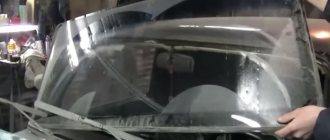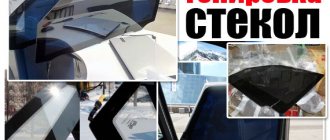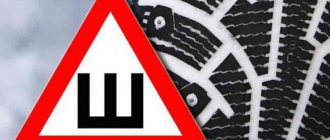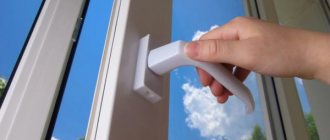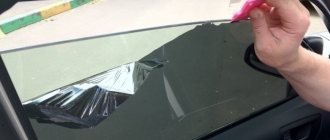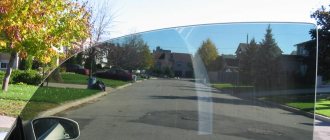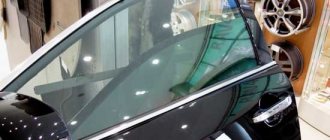Car tinting is not a fashion statement, but protection from bright sunlight, which can turn the interior of a vehicle stuck in a traffic jam into a steam room. They also damage the interior, since the leather upholstery of the chairs suffers from them, losing its presentation. According to GOST 5727-88, the windshield of a car must transmit at least 75% of light, so the possibilities of tinting it are limited. But in order to protect yourself from sun exposure, it is not necessary to fight the visible spectrum. It is enough to get rid of ultraviolet and infrared radiation, which is invisible to the eye, but plays a key role in warming up the interior. For this purpose, an athermal film is used on the windshield, which transmits light waves of the visible spectrum within the limits established by GOST, almost completely blocking access to rays of the infrared and ultraviolet range.
Features of athermal films
Modern technologies make it possible to create unique materials with predetermined properties. These include athermal films, which act as a filter for the invisible range of light waves. Objects receive most of their heat not from visible rays, but in the ultraviolet and infrared range. Therefore, if you block their access to the car interior, it will heat up significantly less, and visibility will remain virtually unchanged, and the glass will appear transparent.
Such films are made using special technologies of multiple layers, each of which is configured to absorb a narrow spectrum of radiation. Taken together, this makes it possible to cover almost the entire ultraviolet wavelength range and more than half of the infrared wavelength.
High-quality films block access to more than 90% of thermal radiation falling on the windshield of a car.
Athermal film is almost invisible on the car glass, so it does not interfere with visibility at night. Its main task is to block heat and ultraviolet rays. In addition, it protects the glass coated with them from chips, scratches and microcracks, and also provides protection for the driver and passengers from flying fragments in the event of an accident.
Advantages of athermal tinting:
- prevents heating of the car interior, making the trip more comfortable and reducing fuel consumption for air conditioning;
- protects plastic, leather and wooden finishing elements from deformation and fading;
- fully complies with the requirements of GOST 5727-88 and traffic regulations;
- does not block the passage of radio waves.
Is it allowed according to GOST
Tinting with athermal film meets all modern standards. Athermal film uses a nanoceramic coating; a thin graphite layer retains ultraviolet and infrared radiation, while transmitting only the visible spectrum of light. Accordingly, tinting with athermal film will meet the strict requirements of the current GOST, which defines the requirements for the parameters of auto glass.
Currently, according to the approved requirements of technical regulations, the windshield and front side windows must have a light transmittance of at least 70%. Thus, the film meets the requirements of the regulations. But, there is one caveat. We must not forget that automobile glass itself has light transmittance, and it is not one hundred percent, but close to 90%. And old worn glass is even less, approximately 70%, or at best 85%.
Let's make calculations for new glass: 0.9x0.8=0.72. This figure meets the requirements of GOST, even a little higher, with a small margin. But for old glass it will be difficult to obtain such a figure. Therefore, we recommend that when purchasing a new car, if you decide to do athermal tinting, do not put it on the back burner.
Types of films
All known types of films can be divided into four main groups:
- painted;
- metallized;
- spatter;
- spatter-metallized.
The first ones are made of polyester, which consists of many layers. Some of them are transparent. Their purpose is to provide strength and protection from fading. Others are painted in the base color of the film. Their number determines the throughput of the film - the more such layers, the darker the material looks. The advantage of this type of film is its low price and wide range of colors.
In metallized materials, some of the polyester layers have a very thin coating, which is usually made of aluminum. This material reflects infrared radiation much better than painted films, which means it better protects the car interior from heating.
In spatter film, the desired color of the product is obtained by using coated layers applied through ion exchange. Technologically, this is the most complex and expensive manufacturing method. This method allows you to make a perfectly smooth coating from almost any substance. The materials produced in this way are highly wear-resistant and practically do not fade. Spatter metallized films are a combination of the three previous technologies.
Athermal films produced by various manufacturers differ both in manufacturing technology and consumer properties. Therefore, when purchasing and installing, special attention should be paid to the following indicators:
- ability to transmit light;
- product color;
- method of installation on glass;
- operational resource.
Depending on the glass on which the film will be installed, its transmission capacity may be different: the most transparent ones are installed on the windshield of a car, and the darkest ones are installed on the rear window.
The color of the film may also vary. Often found in products with a bluish and greenish tint. The Chameleon, which changes shades depending on the lighting, has gained particular popularity.
Reviews from car enthusiasts say that shades of blue tire the eyes during long trips, so despite their beautiful appearance, it’s worth thinking about when using them. The vast majority of car films are self-adhesive, which makes them easier to install. Some vehicle owners prefer to use the services of car dealerships so as not to have to worry about high-quality glass preparation, since they must be perfectly clean. But many do this work themselves.
The coating is installed from the inside of the car: this not only protects the coating from environmental influences and during washing, but also, in extreme situations, protects those inside the car from flying fragments. A well-made and glued coating lasts at least five years, so installing it will allow you to forget about overheating the interior from the sun's rays for a long time.
FAQ:
Used and approved by NASA, the only approved glass protection for the International Space Station.
How is ClearPlex removed or changed?
- ClearPlex uses a unique adhesive that keeps the film firmly adhered to the windshield, but the adhesive is not permanent. If ClearPlex needs to be replaced for any reason, it can be easily removed by simply tearing off one edge of the film and pulling the film out using light, even pressure. Any adhesive left on the windshield can be removed using a non-aggressive cleaner designed to remove adhesive. The new ClearPlex can then be installed on a clean windshield.
Will ClearPlex reduce driver visibility?
- No, ClearPlex is completely clear and is guaranteed not to bubble, crack or yellow for the guaranteed life of the product. When installed correctly, ClearPlex is truly invisible.
Light transmittance of film and windshield
When choosing a film, you should pay attention to its light transmission. GOST requires that for a windshield it is 75%. But if you select and install a film with this indicator, then the car can be stopped at the very first traffic police checkpoint. The reason will be that the glass itself is far from 100% transparent. Most often this figure is around 90%. Therefore, if you take a film that transmits 80% of light and place it on such glass, then the total result will be determined as the product of the transmittance coefficients: 0.8 x 0.9 = 0.72, i.e. 72%. Formally, this figure is less than permissible, so tinting the car in this way will be considered a traffic violation.
Therefore, the film should be installed taking into account the existing glass throughput, which is best measured first. Often, a car may have original factory tint, which will also affect the overall result.
It should be noted that such small deviations cannot be noticed by eye, but the device detects them easily. Of course, it is unlikely that a traffic police officer will stop a car with externally transparent windows to check their throughput. But why violate GOST if it is easy to do without it? For side windows, the requirements are less stringent. A throughput of 70% is allowed for them, so it is fashionable to put a darker film on them. All other things being equal, it will transmit even less heat, which means the cabin will become more comfortable. It is very unpleasant to get into a vehicle that has been standing in the sun for several hours. The sensations from this are comparable to trying to sit on a hot frying pan. The presence of athermal films on the windshield and side windows will easily solve this problem - with them the interior warms up noticeably less.
Advantages and disadvantages
So, the main advantages of thermal film include:
- lowering the heating level of the car dealership during long-term parking;
- the ability to permanently refuse to use protective reflective curtains;
- preservation of the original appearance and properties of the car’s interior upholstery;
- a significant reduction in the amount of glare that interferes with a comfortable ride.
The main advantage that athermal tinting has is to protect the car interior from extreme heat due to exposure to sunlight. And according to motorists, achieving this effect contributes to less regular use of the air conditioner , due to which you can notice significant fuel savings. Such a film blocks ultraviolet and heat rays, while remaining completely transparent to radio waves and other light.
It’s also useful to read: We do tinting of car windows with our own hands: films, tools, techniques
Another important advantage of thermal film is that in the event of an accident, a windshield covered with such tinting will not shatter into small sharp fragments that will injure people in the cabin - this is evidenced by numerous cases of accidents registered with the traffic police.
And in fact, today, tinting car windows using athermal film is a popular way to protect the interior from overheating.
According to numerous reviews from car owners, it does not fade and does not lose its characteristics for a long time . This product is considered especially useful and truly necessary for furnishing cars with leather interiors. After all, leather is more susceptible to cracking than other materials due to prolonged exposure to high temperatures.
However, in the case of other interior trim materials, the effect of using thermal film is also quite noticeable. For example, textile covering stops fading and its rich color remains for a long time.
The only disadvantage of athermal film is the rather high cost of the product. After all, compared to classic tinting, athermal film is 2 times more expensive. However, despite the high price, the demand for athermal tinting does not fall at all, because such expenses, as a rule, turn out to be completely justified. However, there is one more nuance when using athermal film - the transparency of the treated glass. There are types of products that are prohibited from being used due to non-compliance with GOST. That is why, when giving preference to one or another type of film, you should first of all pay attention to the technical properties of tinting.
Films Chameleon
Chameleon has become a popular trend in athermal films. This coating not only has all the useful heat-protective properties, but also has a rich and original color. As a result, the car windshield takes on an unusual shade that shimmers in the sun, similar to the tinting of a business class vehicle. Such films are distinguished by their impeccable quality and high service life.
Chameleon is an excellent design solution for changing the appearance of a car. In the manufacture of this material, a unique technology for applying various metals using magnetron sputtering is used. The result is a coating consisting of almost 20 layers that provide the required protective properties and an eye-catching color effect.
Thanks to the manufacturing technology of Chameleon film:
- does not fade from exposure to direct sunlight;
- provides light transmission in the range from 83 to 90%;
- does not differ at all from factory-made glass for business and premium class cars.
In the sun, such an athermal coating, which initially has a purple tint, shimmers very beautifully with all sorts of delicate colors, which is why it got its name “Chameleon”. When purchasing and installing a coating, special attention should be paid to its throughput. If the Chameleon has it equal to 83%, and the windshield has 90%, then the result will be a maximum permissible figure of 75%. Lower rates will lead to violation of traffic rules and GOST.
Llumar film
Another film that received good reviews not only from our clients, but also from professional experts was Llumar.
The protective films of two manufacturers, SunTek and Llumar, are identical in their properties (adhesive layer, protective varnish layer) and differ only in density (Llumar is thicker). Owners of sports cars often choose it for full wrapping of their cars. A significant advantage of the film is that there is practically no shagreen on its surface, which gives the body additional shine and shine, as well as the “glaze effect” characteristic of premium cars.
Llumar is presented on the market not only as an anti-gravel film, but also as a tint film for cars. In addition to its darkening properties, which help passengers hide from prying eyes, it has a thermal effect. Unlike cheap analogues that have thermal spraying only on top, its entire thickness is stitched with metallized threads. So, among the main advantages of window tinting with Llumar film are:
1. Reducing the air temperature inside your car; 2. Reducing the brightness of headlights; 3. Protection from harmful ultraviolet radiation and overheating; 4. Ensuring safety, since in the event of an accident, the film holds shards of broken glass; 5. Protection of personal belongings from theft, since everything that is inside is hidden from the attacker.
Stages of covering glass with tinting film:
1. A premium wash is carried out to remove dust and dirt from the body; 2. The film is cut; 3. Installed on a soap solution; 4. Molded to fit the windshield using heat; 5. Using a squeegee, remove excess water from under the film.
Please note that after tinting, in order for the film to stick well and dry, you should not lower the windows for 3-4 days in the summer and about 5-7 days in the winter.
What tinting is allowed on the windshield and other car windows: we understand the standards
Until the beginning of last year, the requirements for tinting (more precisely, for light transmittance) of auto glass were contained in GOST 5727-88 “Safe glass for land transport.” Four changes have been made to it since the early 90s. The last of them came into force in 2002. It established the following requirements for light transmission of auto glass:
- The light transmission coefficient of windshields of vehicles and trams should not be less than 75%. Note 1: The windshield at the top could have a light protection strip. GOST 5727-88 contained a formula for calculating its width. Usually it turned out to be no wider than 15 cm, but the formula took into account, in addition to the work of the wipers, also the boundaries of regulatory zones, as well as viewing angles for the driver under different driving conditions.
- light transmission of non-window glasses included in the so-called. the “standard field of view P”, in particular of the front door glass, should not be less than 70%;
- The light transmission of other non-window glasses is not standardized.
From 01/01/2015, the new GOST 32565-2013 came into force under the same name. What is the permitted tinting of front windows in 2019? GOST 32565 somewhat relaxed the requirements for the value of their light transmission coefficient, lowering its lower threshold from 75 to 70%. This change legitimizes the practice of tinting windshields with clear or colored athermal films, which has been very popular in recent years (see below).
The requirements of the new GOST for the light transmission of windshields are also duplicated in the technical regulations of the Customs Union (CU), which came into force in the Russian Federation in February 2015, called “On the safety of wheeled vehicles.” What is the permitted tinting of front windows in 2020 according to this document? Their minimum light transmission is set to the same 70%, i.e. the new GOST and technical regulations of the Customs Union have been agreed on this issue.
The new GOST and CU technical regulations contain another innovation regarding windshields. They set the maximum permissible width of the shading strip for them at 140 mm (for categories M1, M2, N1), and the light transmission of the strip is not standardized.
What percentage of tinting is allowed for non-windshield windows by these regulations? Firstly, the new GOST divided all vehicle glass into two categories:
- category 1 – glass providing forward visibility to the driver;
- Category 2 – glass that provides rear visibility to the driver.
Both of these categories are divided according to a geometric principle. On the driver's seat, the manufacturer must indicate (in a coordinate manner) the so-called. "point R". If a vertical plane is drawn through it, perpendicular to the longitudinal median plane of the car, then its glass that is in front of the vertical plane will belong to category 1, and the glass that is behind it will belong to category 2.
According to the new GOST and technical regulations of the Customs Union, the light transmittance of glasses of categories 1 and 2 must be at least 70%, i.e. no worse than windshields. However, if the car has two external rear-view mirrors, then the light transmission of category 2 glass is not standardized.
Note 2: Traffic regulations allow the use of curtains on bus windows, as well as blinds and curtains on the rear windows of passenger cars equipped with two (right and left) exterior rear view mirrors. It turns out that you can have a completely curtained (and tinted) rear window.
